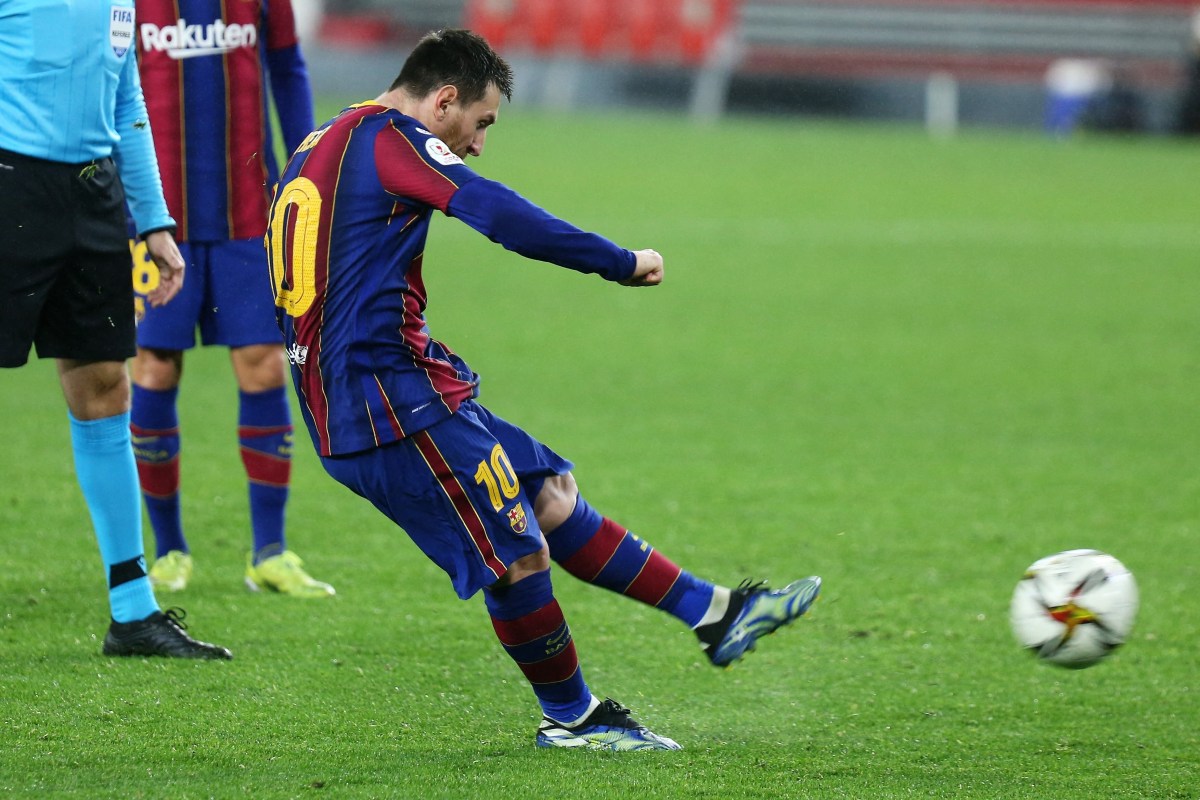What is Lionel Messi in 2021? Had he got his way last summer, we wouldn’t even have an answer to this question, at least not in a Barcelona shirt. On the back of a trophy-less 2019-20 season and amid rumoured disillusion, Messi decided to call time on his career in Catalonia – only to reverse that decision only a matter of days later.
And so he remained, taking up a slightly different role under Ronald Koeman in 2020-21 than he has occupied previously. For starters, he’s now receiving the ball on the left wing more than at any time in the last decade.
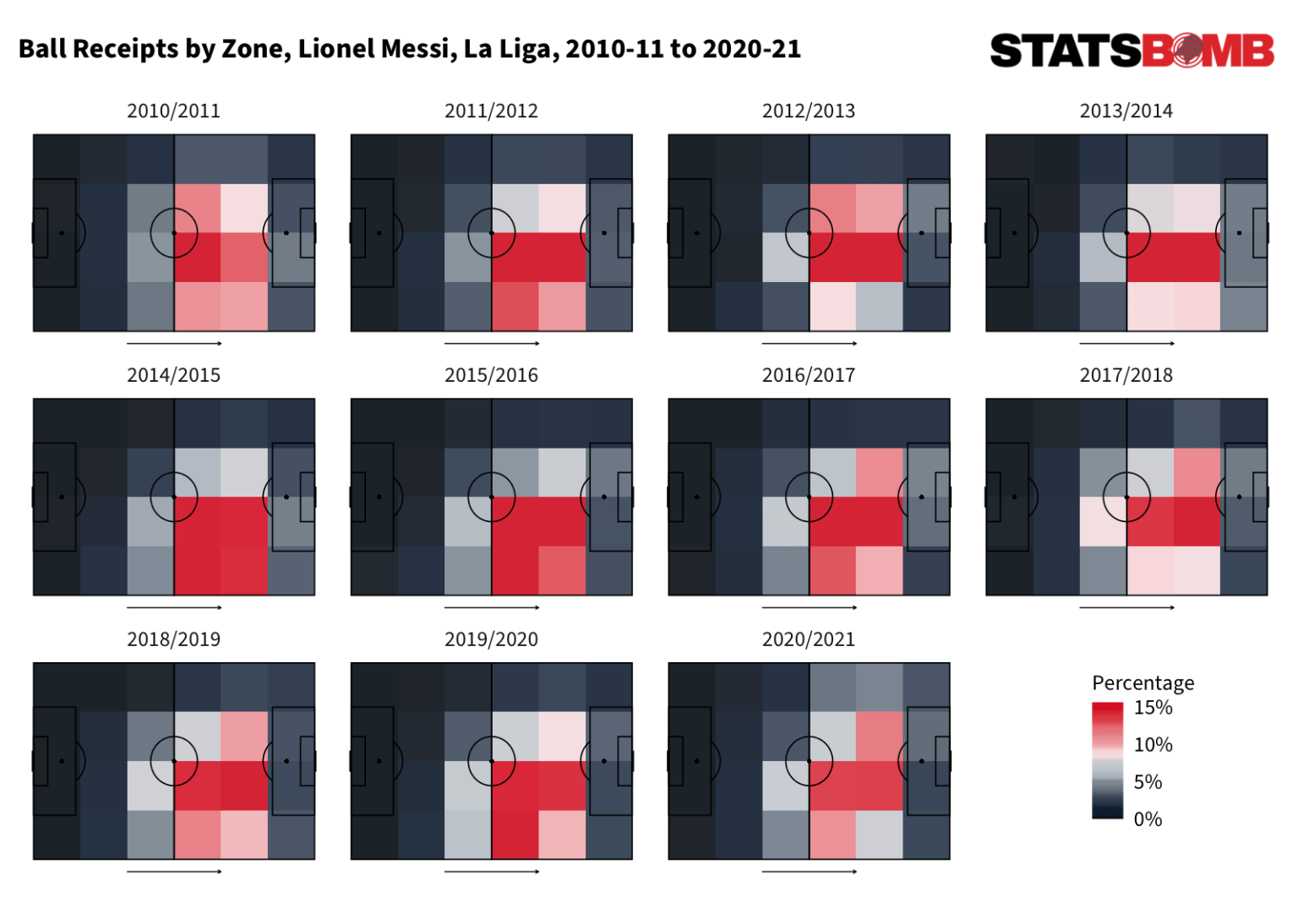
The right-hand channel remains his, but this season – playing more centrally overall – he’s been able to drift left and right as he wishes.
That isn’t the only new addition to Messi’s game that we’ve seen this season. At the start of 2020-21, we saw for the first time that he may be human after all.
Dips in form happen to every player, but when you’re Lionel Messi that usually means finishing chances at a rate in touch with other mere mortals, rather than the disparate sharp-shooting we’ve all become accustomed to.
It feels sacrilegious to say, but for the first time in his career we witnessed a sustained period of poor Messi finishing.
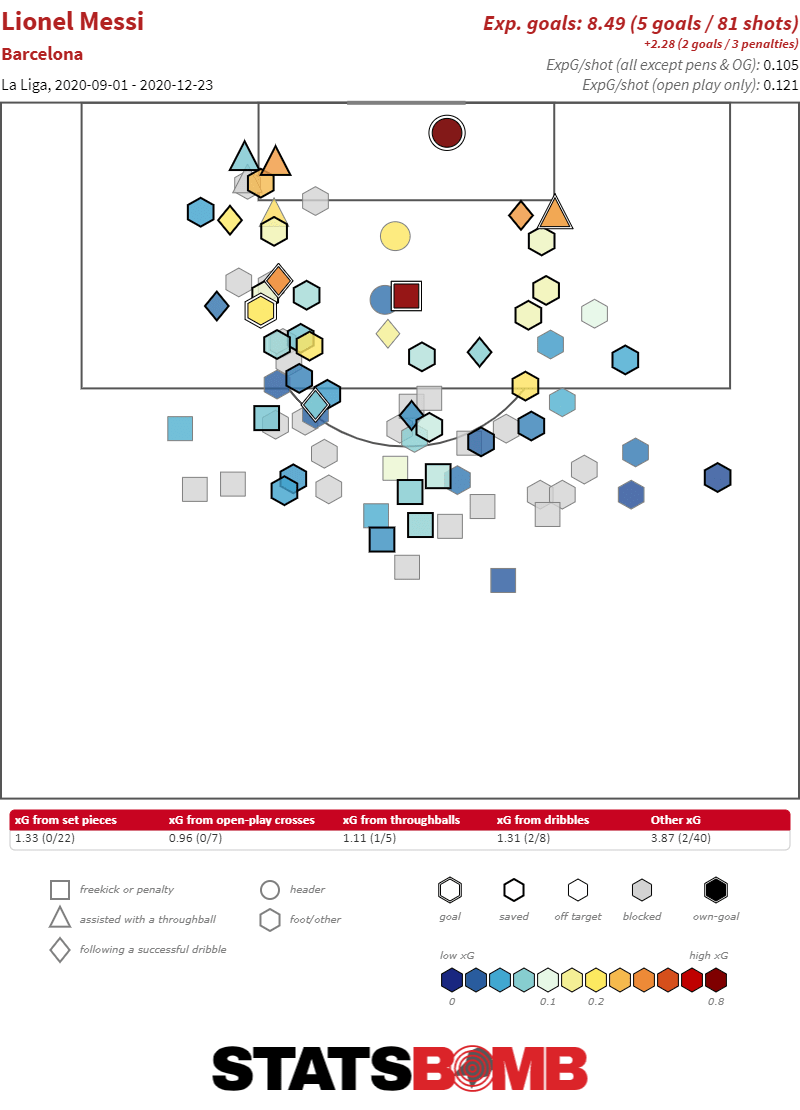
Just five non-penalty goals from 8.5 xG pre-Christmas meant that not only was Messi finishing poorly, he also had the biggest underperformance on expected goals of any player in La Liga.
You’d be forgiven for thinking that it was the end of an era. The narrative was there for all to see. At the age of 33, the best of Messi was now a thing of the past. Barça morale was hardly helped by struggles to adjust to life under Koeman, Blaugrana were fifth in the table heading into Christmas, eight points behind leaders Atlético Madrid.
The club’s decision to allow Messi an extended festive break in Argentina now looks a shrewd one, to put it mildly. Barcelona’s record of 13-2-0 since has seen them close the gap to Atleti to just four points with ten games to play and, fear not, a rested Messi has rediscovered his superpowers. He’s back to scoring at twice the rate of his expected goals again.
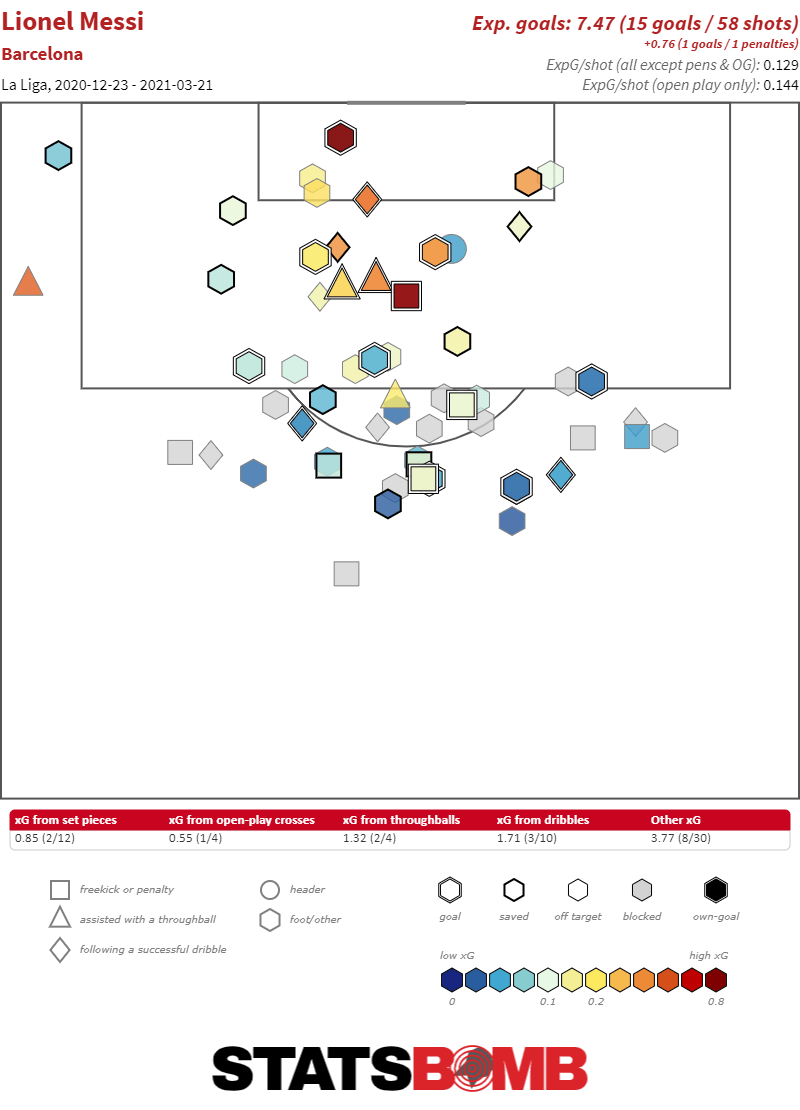
There’s a stark polarity between his pre-Christmas shot conversion rate of 6% to the 26% conversion he’s put up since, a clip that is up there with the best in his career and one that has been aided by an uptick in overall chance quality from 12% to 14%.
There’s also signs that he’s taking more responsibility in the build-up phase than ever before, whilst easing the burden of chance creation onto his teammates a little more. His xG assisted numbers from open play are at their lowest rate for seven seasons, they still remain ahead of his Barcelona teammates but, with four Blaugrana teammates putting up at least 0.20 expected goals assisted per 90 too, there’s far more parity than in previous campaigns.
It’s also noteworthy that he’s become more selective with his ball carrying, attempting (6.3) and completing (4.0) fewer dribbles than at any time in his career.
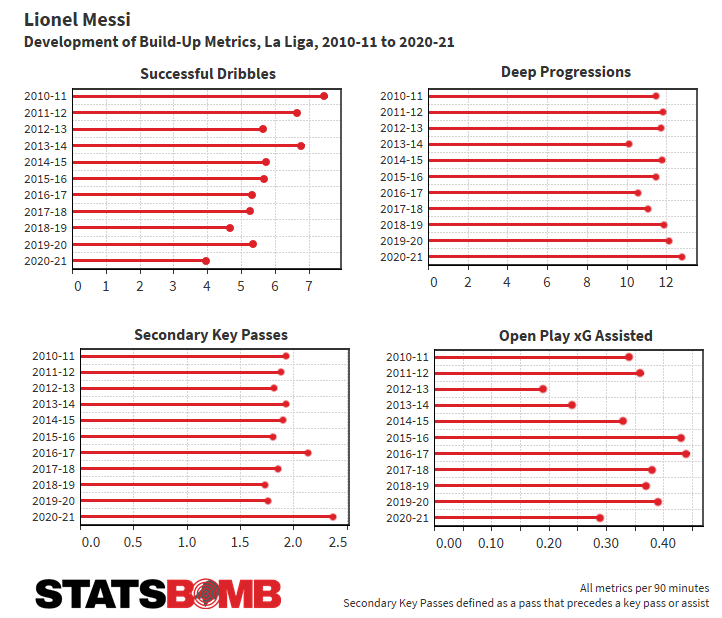
The decline in xG assisted and dribbling numbers have been replaced by an increase in creative workload earlier in the play. He’s moving the ball into the final third more than at any previous moment in his career (12.8 times per 90), shouldering the responsibility of ensuring Barcelona reach attacking positions, and has also seen a surge in his secondary key pass numbers – a pass that precedes a key pass or assist.
No player in La Liga has made more secondary key passes than Messi’s 2.4 per 90 minutes, but dig a little deeper and there’s something even more curious going on.
Of Messi’s 62 secondary key passes, the final shot itself was taken by Messi on 26 occasions. That is to say, over 40% of the time, the player that has received the pass from Messi has returned the ball to him to take the shot. And like so many outstanding metrics before, this is something that is seemingly unique to him. It works out that this happens nearly one time per match – no other player in La Liga is doing this every two matches, let alone every one, with next-best Nabil Fekir managing it slightly more often than once every three games.
The importance of Messi to Barça’s success on the pitch has never been more stark. Compare the share of ball progression and shot taking between the Barcelona team of 2014-15 and that of 2020-21.
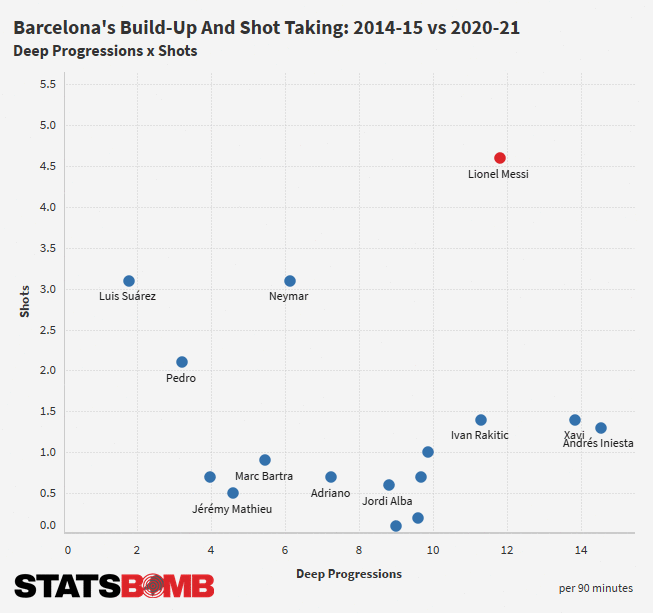
The times of the ‘MSN’ triumvirate, where he could weave and dovetail around the penalty box with Luis Suárez and Neymar at peak age, are a distant memory. The years where Xavi and Andrés Iniesta would take on most of the responsibility for advancing the ball towards goal from the middle third have been left behind. Where Messi was previously able to look to other iconic talents in seasons gone by, he is now taking on more influence both outside of and inside the final third.
After topping out at ~0.75 per 90 in the early part of the decade, his expected goals numbers have settled around the 0.60 per 90 minutes mark, consistently remaining around that level in each of the last six seasons, excluding a slight dip in 2019-20 and, at 33, his expected contribution rates are still miles ahead of the competition. The question still remains: if Karim Benzema and Luis Suárez, for example, are world class, what does that make Messi?
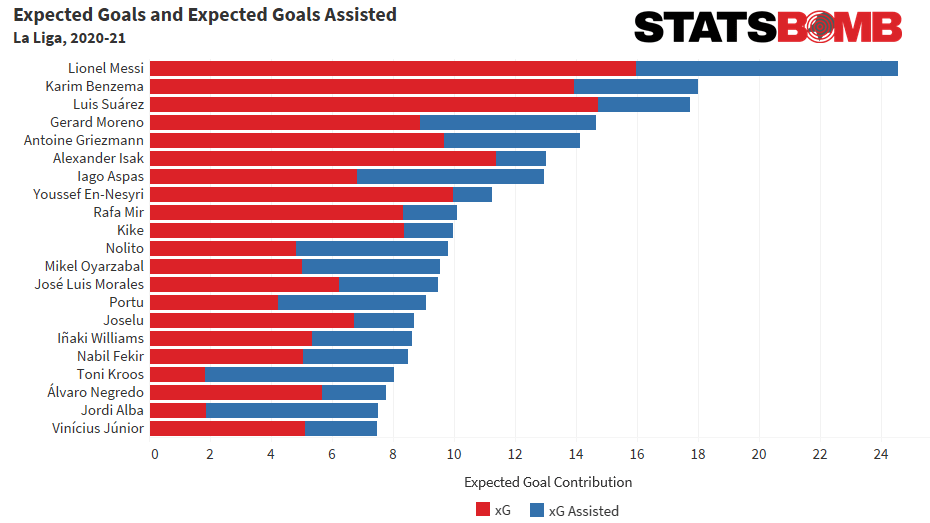
The ‘Lionel Messi: 2021 edition’ is one that is dragging Barcelona all the way to a potential 27th La Liga title, should current form persist. Even entering what will be the final seasons of his career, he remains competition only to himself, contributing more to the build-up, chance creation, and chance finishing than any of his colleagues. Whether we’ll be able to write about the 2022 edition, only time will tell.
StatsBomb has made full data available for every single Lionel Messi game in La Liga between 2004-05 to 2019-20. If you want to conduct your own analysis of Lionel Messi throughout the years, you can find out how to access and use the data here, with further examples and code here.
